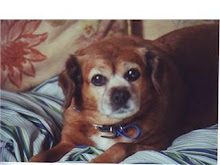As I wove my way through the crowd I got a slight push from behind, only a slight push but it was definitely a nudge to get me out of the way.
I turned and my eyes met this large bear-like brindle-coloured dog. “I’m sorry,” said the owner and they strode past me.

I raced to catch up.
“Can I take a photo of your dog,” I asked waving my camera at the ready. “I haven’t seen one like him before. What breed?”
“He’s an Akita Wolf Hound,” said the man holding the lead. He stopped and the large dog paused with him. “I’m in a bit of a hurry. Can you be quick?” I pointed the camera.

Two quick snaps and they were on their way. They maneuvered their way through the crowd with the dog in front and I suspect still giving gentle nudges.
I saw them again about 30mins later at an ATM but they were still in a hurry.

I checked out the breed and Akita appears to be a breed on its own. Perhaps this one has been crossed with a Wolf Hound. The only difference I saw in him from the picture on the Internet is his tail. Akitas seem to have tightly curled tails.
See the tails in these two pictures and the picture of the Japanese statue.

 The breed originates in Japan and this is what one breeder says about them.
The breed originates in Japan and this is what one breeder says about them.‘Akitas are most striking and impressive creatures with an attitude of nobility and an appearance of strength and power. Their most noticeable physical characteristic is a large, bear-like head with erect, triangular ears set at a slight angle following the arch of the neck. They have thick, stand-offish coats, and tight cat feet, well knuckled up. Their tails curl over the top of the back in a graceful sweep down the loin, into a gentle curl, or into a double curl. Their colors are rich and clear, like paint on a canvas.’
 You may like to read the story that prompted this statue which is in front of the Odate Station in Japan.
You may like to read the story that prompted this statue which is in front of the Odate Station in Japan.
For the Japanese, the most famous Akita is the Chuken Hachiko, which means “loyal Hachiko”, but he is usually referred to as Hachiko.
Hachiko, a white male Akita, was born in Odate, Akita Prefecture in November 1923. Two months old, he was sent to the home of Professor Eizaburo Ueno in Tokyo. The Professor named the puppy Hachi and called him Hachiko. At that time, Professor Ueno’s residence was in a suburb of Tokyo in the vicinity of Shibuya Station, and he used the train from that station to the agricultural experimental station in Nishihara where he worked.
May 21, 1925, Hachiko was at Shibuya Station as usual, waiting for his master’s arrival on the four o’clock train. However, Dr. Ueno would not return this time since he tragedly had suffered a stroke and had died at the university. Hachiko was by then eighteen months old. The next day and for the next nine years, Hachiko returned to the station and waited for his beloved master before walking home, alone. Hachiko was sent to homes of relatives or friends, but he always continued to await his master, who was never to return, at the train station.
Nothing and no one could discourage Hachiko from maintaining his nightly vigil. It was not until he followed his master in death, in March l934, at the age of 11 years and 4 months, that Hachiko failed to appear in his place at the railroad station.
The fidelity of Hachiko was known throughout Japan, owing to an article, “Faithful Old Dog Awaits Return of Master Dead for Seven Years” in the October 4, 1933 issue of Asahi Shinbun (Asahi News. Upon his death, newspaper stories led to the suggestion that a statue be erected at the station. Contributions from the United States and other countries were received. Today, the statue of Hachiko, pays a silent tribute to the breed’s faithfulness and loyalty. A bronze statue of Hachiko was erected in 1934 at his waiting spot outside the Shibuya railroad station, which is now probably the most popular rendezvous point in Tokyo. Hachiko was mounted and stuffed and is on now on display at the Tokyo Museum of Art.During the World War II, the statue was melted down to help the Japanese military. A new statue was returned to the Shibuya station in 1947. Another statue of Hachiko, although not equally well known, is erected in front of the Odate station. This statue was erected in 1935. It too, was melted down during World War II and was re-erected in 1987.


1 comment:
What a big dog !
Nice that you are checking my blog.
I don`t know more aboyt Gucci pregnancy yeat. She is tired and somewhat different in her behaviour.
Hedvig
Post a Comment